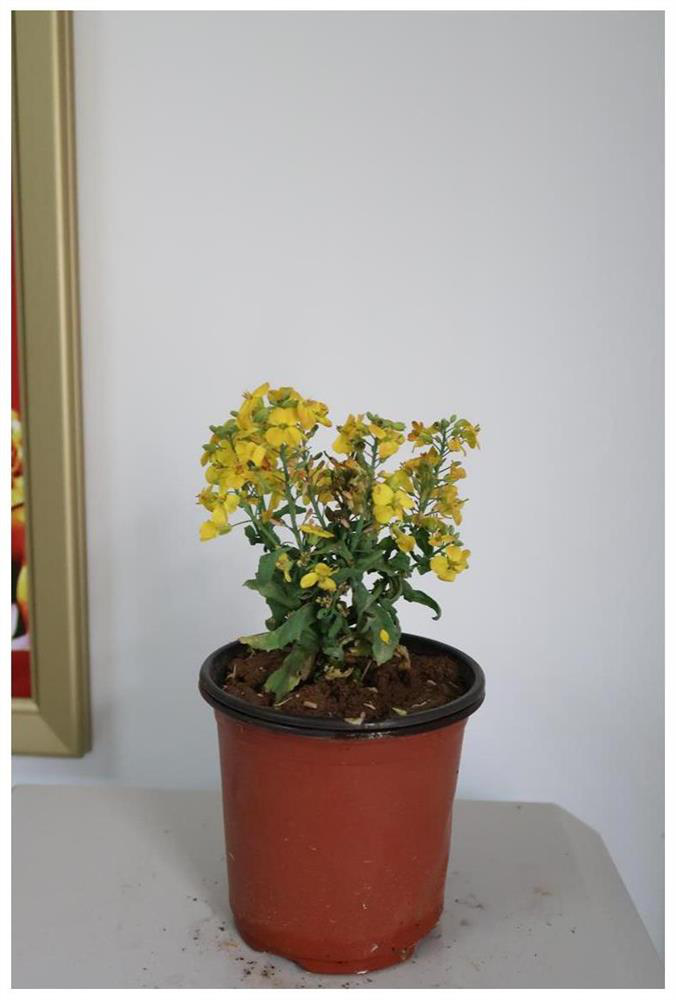Ornamental rape variety cultivation method suitable for miniature bonsai
A cultivation method and technology of rapeseed, applied in botany equipment and methods, applications, flower cultivation, etc., can solve the problems of large biomass, lack of potential to form miniature bonsai, and inability to place miniature bonsai, so as to achieve the effect of reducing biomass
- Summary
- Abstract
- Description
- Claims
- Application Information
AI Technical Summary
Problems solved by technology
Method used
Image
Examples
Embodiment 1
[0078] Embodiment 1 The search and determination of the characters required for the cultivation of miniature bonsai rapeseed varieties
[0079]Miniature bonsai rape, it is conceivable that the plants of rape must be very short. From the perspective of traditional breeding techniques and the research status of rapeseed germplasm resources, the dwarf resources of rapeseed are relatively abundant. Through the Pubmed entry on the NCBI website (https: / / www.ncbi.nlm.nih.gov / ), 67 literature discovery results were obtained by searching with the keywords "Brassica napus" + "dwarf". After downloading the literature, read each One literature, looking for literature resources of rape dwarf mutants about 20cm, found only three, namely Cheng et al. BMC Plant Biology 2019: 500; Zhao et al. Theoretical and Applied Genetics (2019, 132: 1435- 1449); Zheng et al. Plant Cell Reports (2019, 38: 883-897). Further through the research results, it was found that the research materials and trait co...
Embodiment 2
[0080] The breeding process of embodiment 2 miniature bonsai (ultra dwarf pole) rape variety
[0081] In the flowering period of 2018, the conventional rapeseed varieties Zhongshuang No. 11 (Guoshenyou 2008030) and Ningyou No. 22 (Su Shenyou 201403) were used as the female parent, respectively, and the ultra-dwarf rapeseed resource Aiyuan No. 1 (Pu Huiming et al., Crop Variety Resources, 1995, (1): 23-24) crossed to obtain two F1 seeds (referred to as ultradwarf F1). In June 2018, the ultra-dwarf pole F1, Aiyuan No. 1, etc. were planted in the indoor plus generation planting mode. Indoor plus generation planting mode, specifically: seeds are vernalized immediately after germination in a petri dish (30 days at 4°C), and then planted in a nutrient pot with a side length of 10 cm (one seedling per pot) to grow to three leaves , and then take out the whole soil of the seedling belt from the nutrition pot, transplant it into a large round pot with a diameter of 30 cm, and continue...
Embodiment 3
[0082] The breeding process of embodiment 3 colored bonsai rape variety
[0083] While cultivating common-color miniature bonsai rape, we introduced the rapeseed purple flower germplasm resource (Chuancai No. 5), and we also took out our own white flower resource J328 and golden flower resource 97088 (Zhang Jiefu, etc.) from the seed bank. , Chinese Journal of Oil Crops, 2000, 22(3): 1-4). In March 2018, Aiyuan No. 1 was used as the female parent, and Chuancai No. 5, J328 and 97088 were used as male parents, respectively, and three F1s were obtained by crossing. Planting in the plus generation planting pattern. The single plant with shrunken leaves was selected at the three-leaf stage. At the early flowering stage, the F1 single plant was used as the female parent, and it was backcrossed with the three colored flower parents, and the BC1 seeds were harvested at the mature stage. In October 2018, the BC1 generation was planted according to the field planting model. During th...
PUM
 Login to View More
Login to View More Abstract
Description
Claims
Application Information
 Login to View More
Login to View More - R&D Engineer
- R&D Manager
- IP Professional
- Industry Leading Data Capabilities
- Powerful AI technology
- Patent DNA Extraction
Browse by: Latest US Patents, China's latest patents, Technical Efficacy Thesaurus, Application Domain, Technology Topic, Popular Technical Reports.
© 2024 PatSnap. All rights reserved.Legal|Privacy policy|Modern Slavery Act Transparency Statement|Sitemap|About US| Contact US: help@patsnap.com










